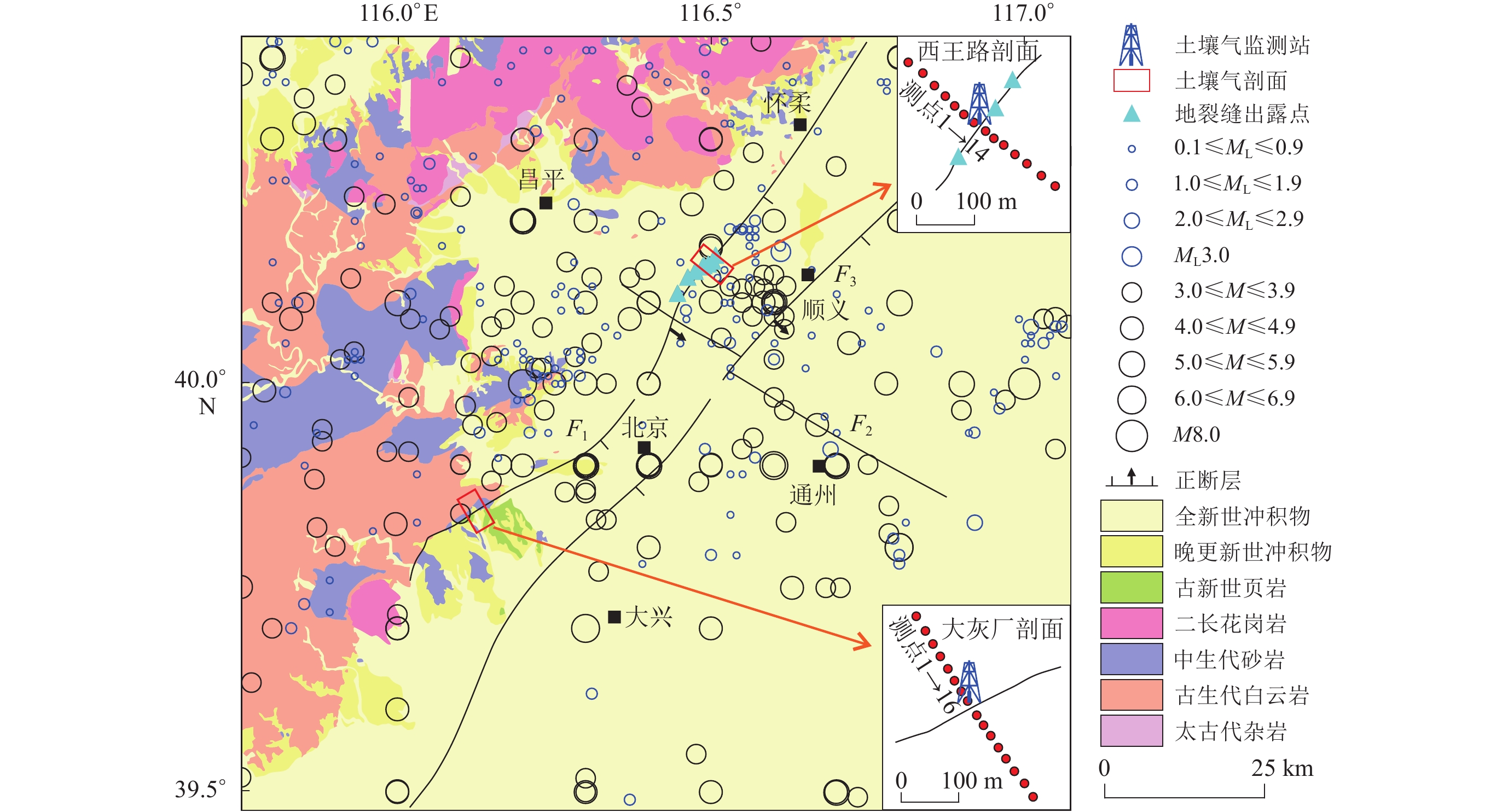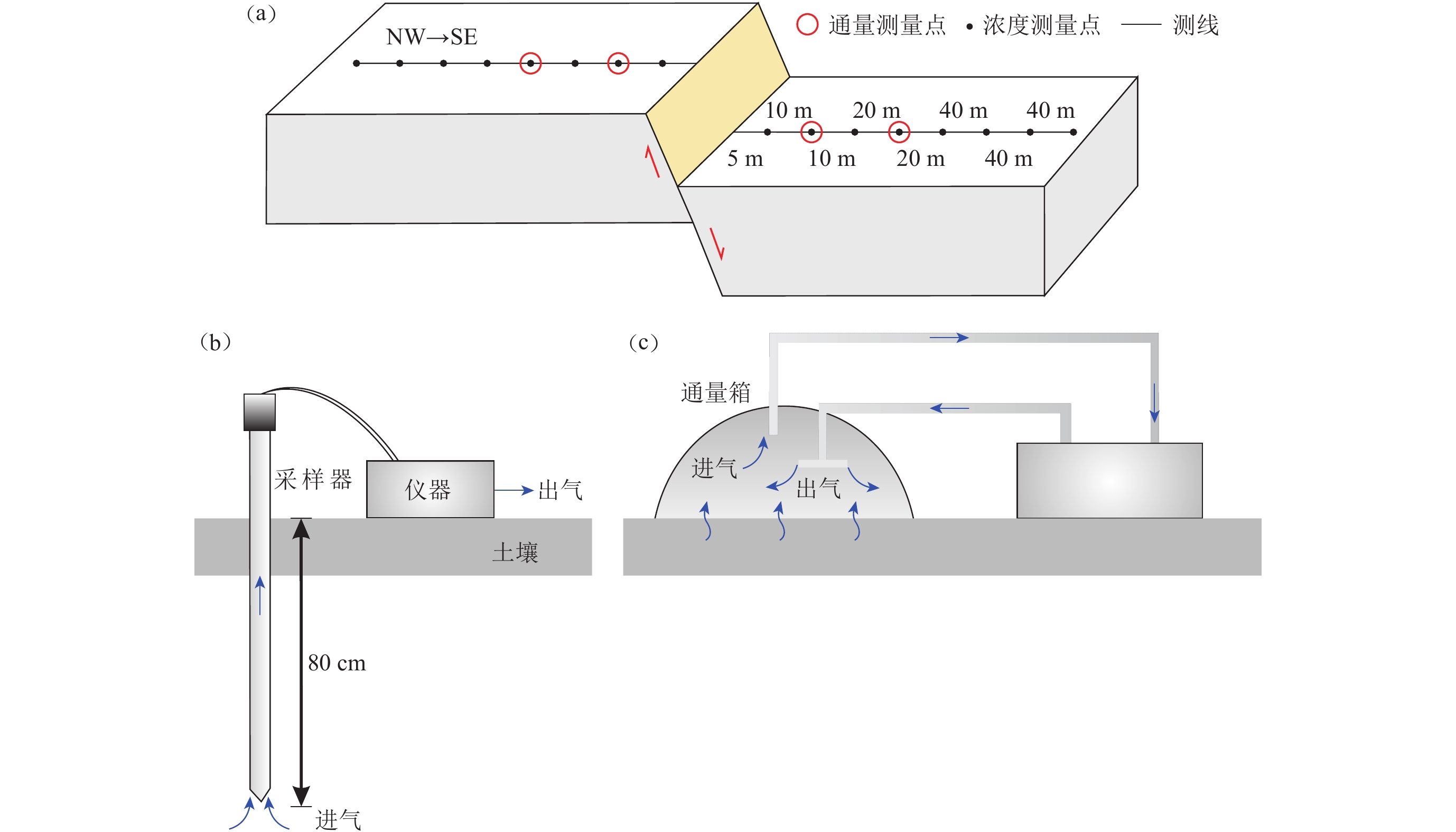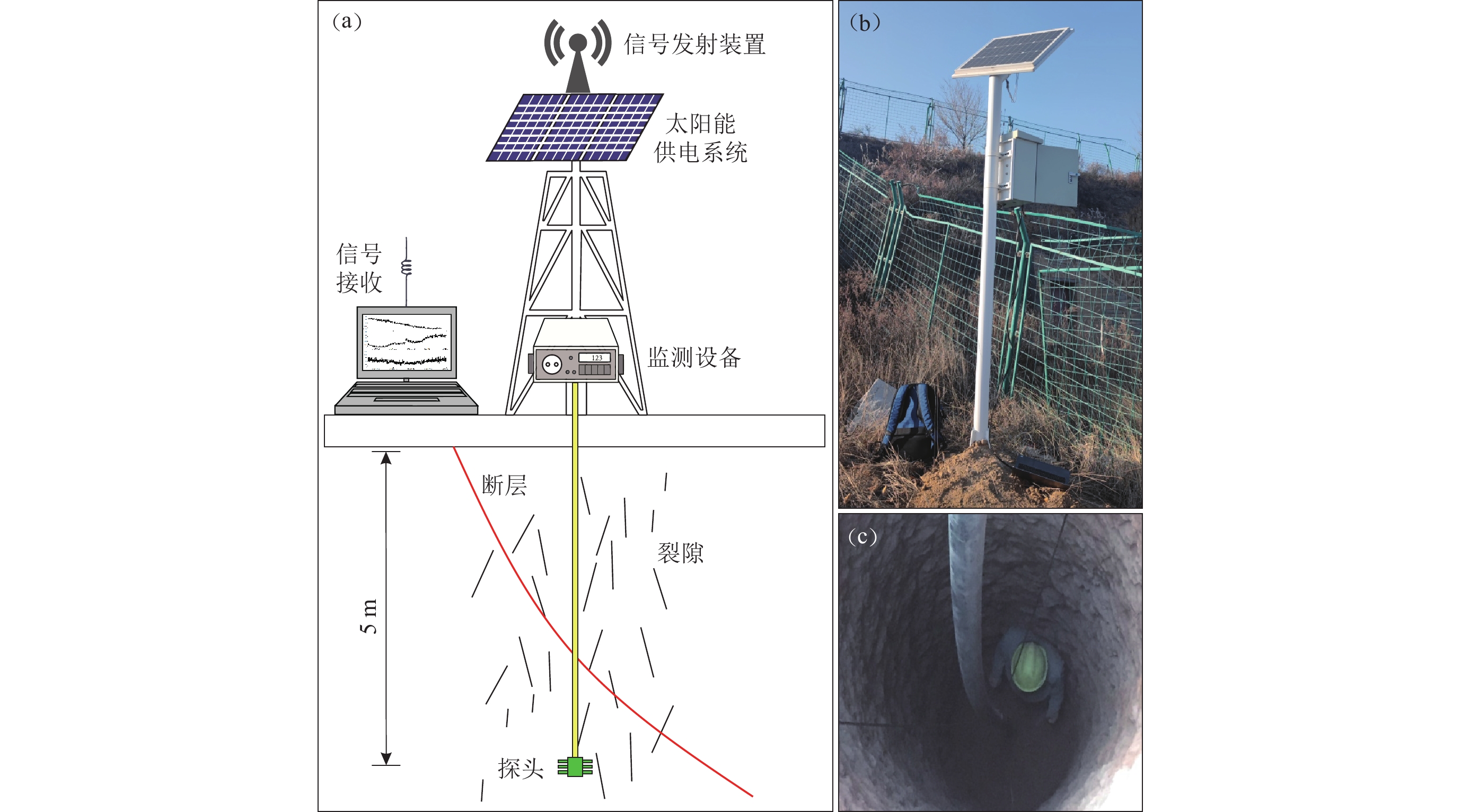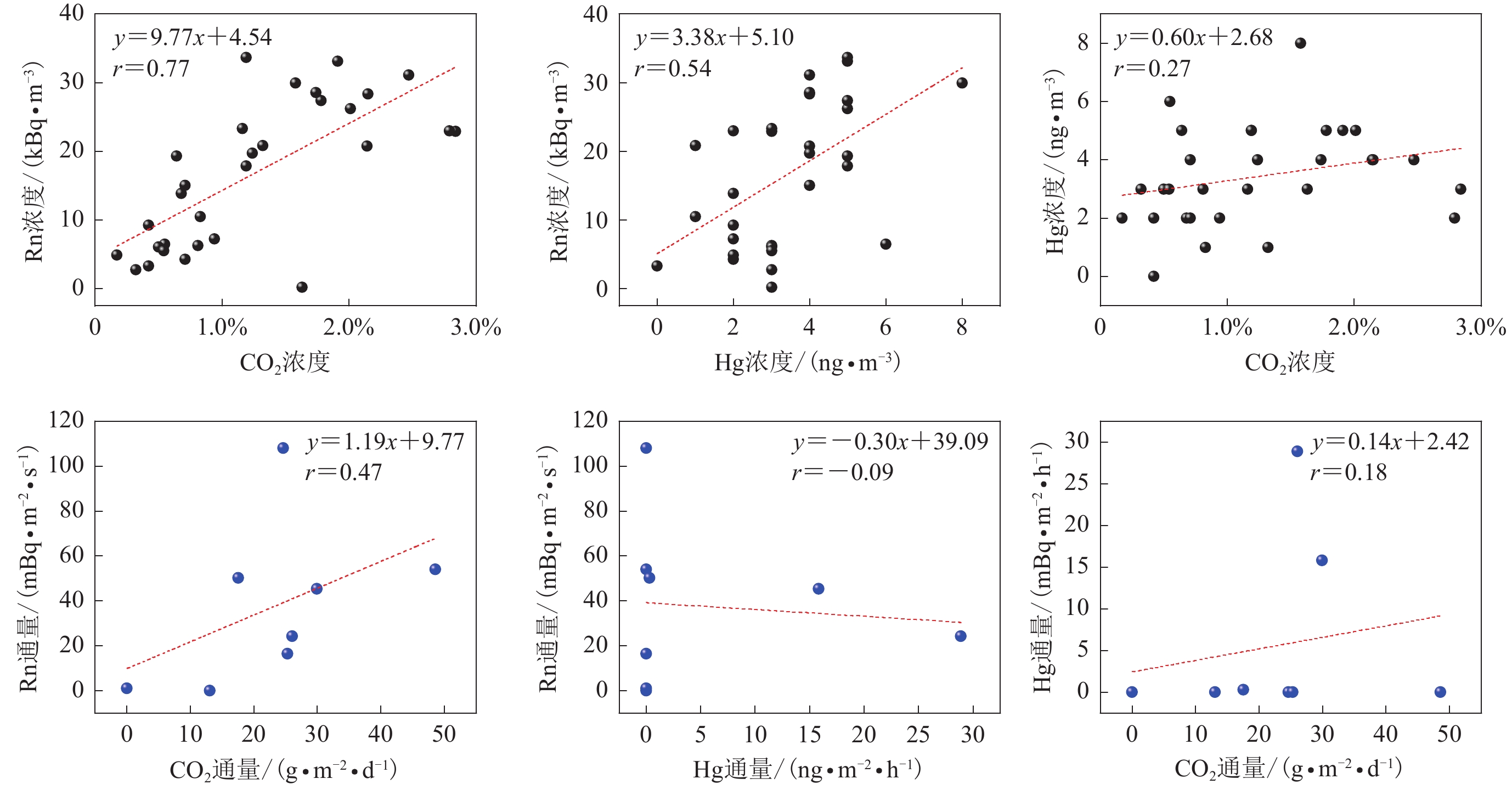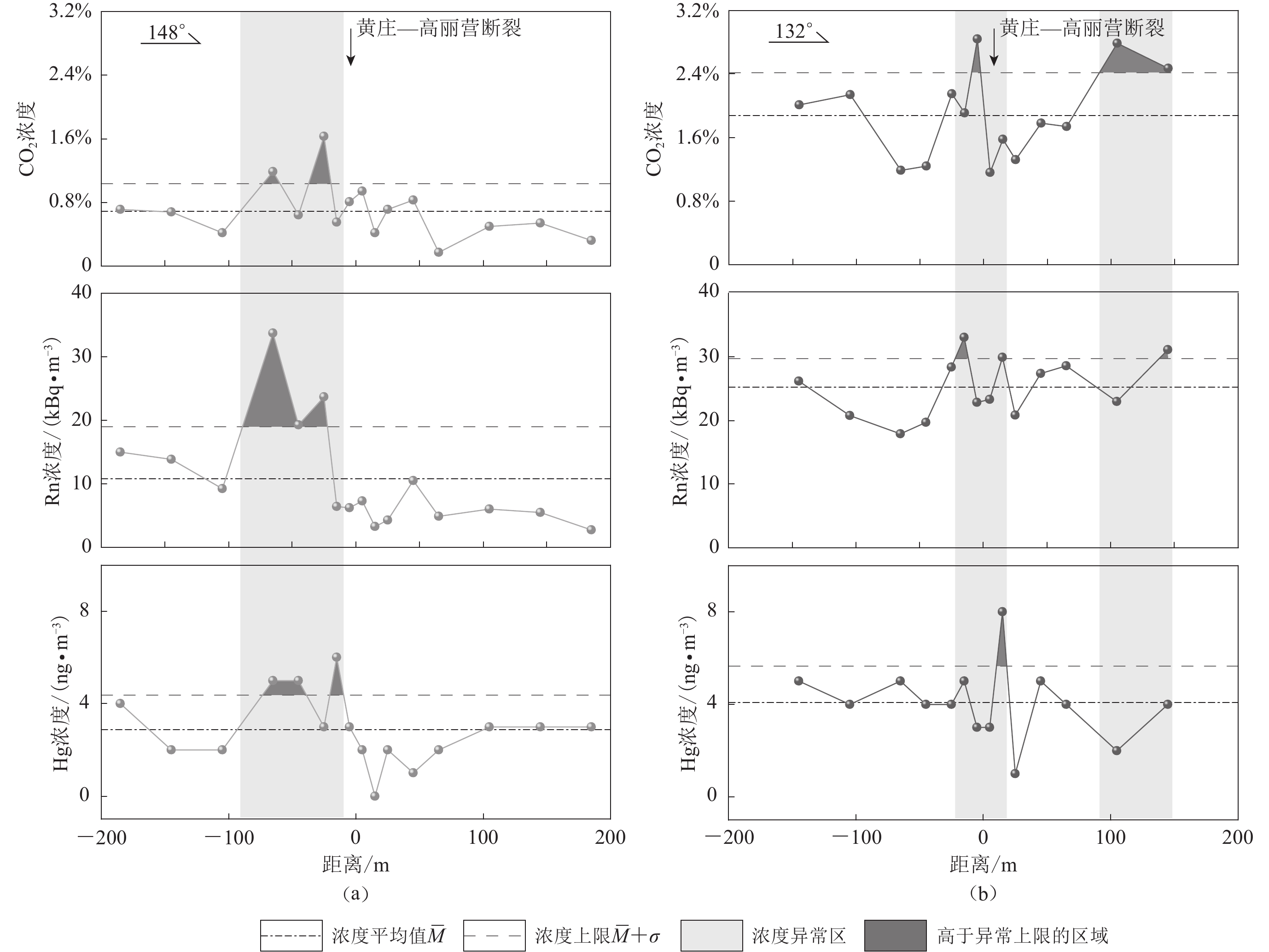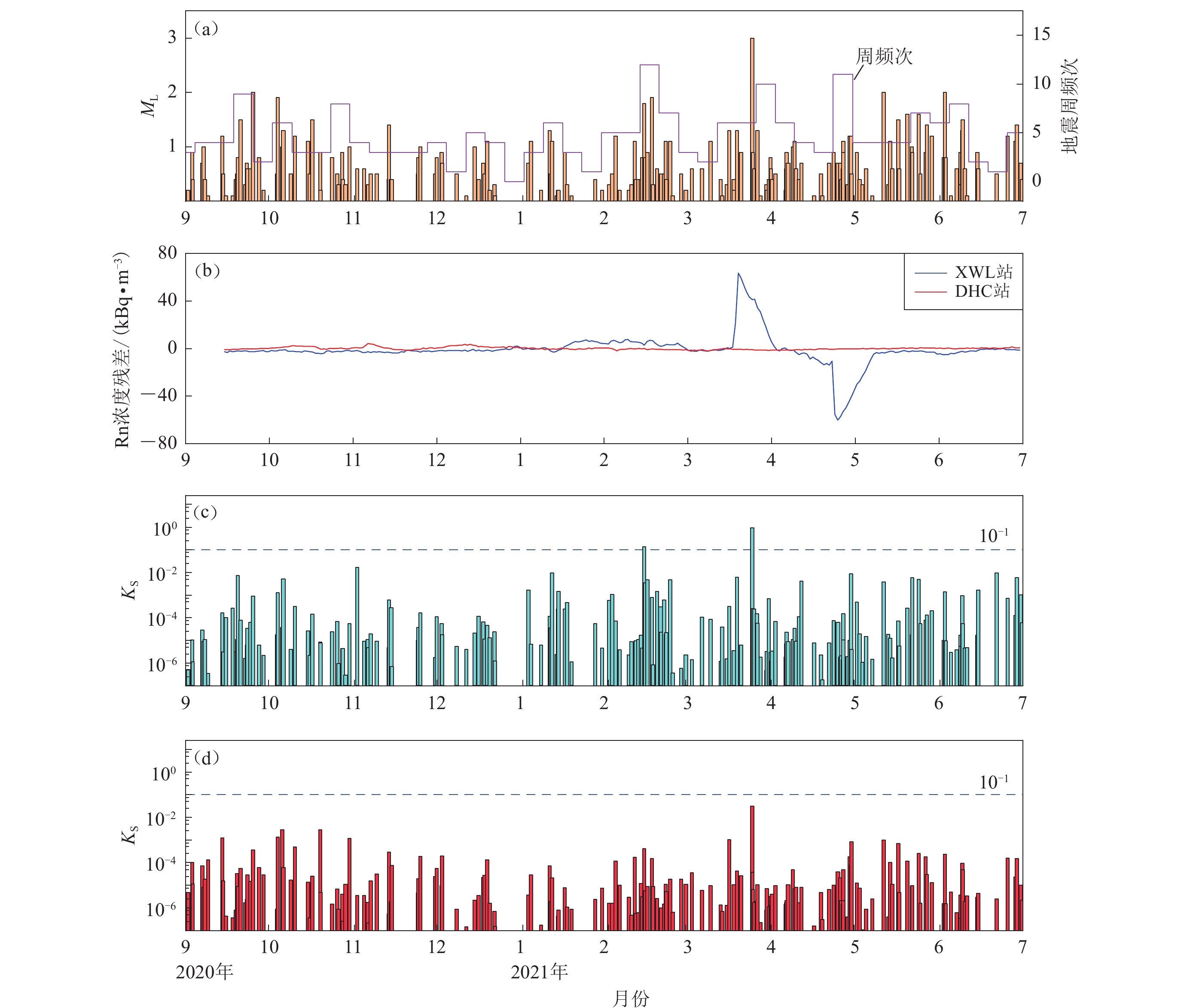Geochemical characteristics of soil gases on the Huangzhuang-Gaoliying fault in Beijing and their indications for seismic activity
-
摘要: 通过对2017年5月土壤气CO2,Rn和Hg的野外流动测量以及2020年9月1日至2021年6月30日期间土壤气监测站Rn的连续监测,利用残差法和地震指数KS方法对黄庄—高丽营断裂南北段的活动差异和区域地震活动进行了分析。结果表明,与首都圈地区其它断裂相比,黄庄—高丽营断裂是首都圈地区活动性相对较强的活动断裂,断裂北段的土壤气体浓度和通量较南段更高,且北段上盘的CO2和Rn浓度明显高于下盘,指示断裂北段具有更强的活动性。对土壤气连续监测站数据进行分析,结果显示监测站的Rn浓度与气温、土壤温度和气压之间无明显相关性。2021年3月25日北京顺义ML3.0地震前6天,监测站记录到Rn浓度出现异常升高,增加了一倍,且震后异常持续了一个月。顺义ML3.0地震前后Rn浓度的异常变化表明监测站的土壤气Rn浓度对KS>0.1的地震有很好的响应。Abstract: Based on the field flow observation of soil gas (CO2, Rn and Hg) in May of 2017 and continuous monitoring of soil gas Rn from September 1, 2020 to June 30, 2021, the residual signal and seismic index KS are used to study the activity difference between the south and north segments of Huangzhuang-Gaoliying fault and their regional seismicity. The results indicate that this fault is a relatively active fault compared with other faults in the capital circle region of China. The concentrations and fluxes of the soil gases in the north segment of the fault are higher than those in the south segment. And the CO2 and Rn concentrations in the hanging wall of the northern segment are significantly higher than those in the footwall. These indicate that the northern segment of the fault has stronger activity. Analyses on the continuous monitoring station data of soil gas Rn show there is no significant correlation between Rn concentration and air temperature, soil temperature, and air pressure. The Rn concentration at the monitoring station, six days prior to the Shunyi ML3.0 earthquake on March 25, 2021, was recorded to significantly increase, which doubled and persisted for a month after the earthquake. The anomalous variations of Rn concentration before and after the Shunyi ML3.0 earthquake indicate that the soil gas Rn concentration at the monitoring station exhibits a strong response to earthquakes with KS>0.1.
-
Keywords:
- soil gas /
- geochemistry /
- seismicity monitoring /
- Huangzhuang-Gaoliying fault
-
引言
依据Reid (1910)提出的弹性回跳理论,断层源上强震的复发满足准周期性模型。我国的海原断裂带、可可托海—二台断裂带、鲜水河断裂带、小江断裂带的古地震和历史地震资料均显示出强震的周期性复发行为,因此特征地震的复发行为是普遍的(宋方敏等,1998)。特征地震具有原地复发、震级相近、位错和破裂尺度大致相同的特点(Schwartz,Coppersmith,1984)。现如今特征地震和准周期复发模型是活动断裂强震危险性评价的重要理论基础。然而,大多数活动断裂上地震的复发间隔并不满足准周期性,而是表现为复发间隔的变化。从本文搜集到的45条活动断层古地震复发间隔的统计来看,经无量纲标准化处理(间隔/均值)的复发间隔分布在0.26—2.95之间,具有较大的不确定性,但是复发间隔数据的分布又大致满足正态分布(图1)。这一统计结果与前人的统计结果是一致的(Nishenko,Buland,1987)。可见,大型活动断裂上强震的复发行为介于完美周期性与完全随机性之间,为此,概率方法被用于当前活动断裂未来强震危险性的评价,诸如正态分布、对数正态分布、伽玛(Gamma)分布、韦伯(Weibell)分布等多种概率分布模型被用于表达强震复发间隔的概率分布特征,其中,考虑随机扰动的布朗过程时间(Brownian passage time,简写为BPT)模型是Ellsworth等(1999)和Matthews等(2002)在弹性回跳理论基础上提出的具有一定内在物理基础的强震复发模型,该模型随着美国加州地震概率工作组(Working Group on California Earthquake Proba-bilities,简写为WGCEP)在对加州地区未来30年强震发生概率评价工作中的使用(WGCEP,1999)逐步得到广泛重视;WGCEP (2003, 2007)在其后续工作中时间相关的地震复发模型更是只采用BPT模型,而放弃了其它模型,BPT模型因而成为用于断层强震复发概率评估最重要的模型。
强震概率危险性评估假定某条大型活动断裂复发间隔的概率密度分布函数为f (t),前一次地震发生至今的时间为离逝时间Te,则该断裂上未来时段ΔT内发生强震的概率P随着Te而变化,表示为(Wesnousky,1986)
$P\left({{T_{\rm{e}}}, \Delta T} \right) \text{=} \frac{{\int_{{T_{\rm{e}}}}^{{T_{\rm{e}}} + \Delta T} {f\left(t \right){\rm{d}}t} }}{{1 - \int_0^{{T_{\rm{e}}}} {f\left(t \right){\rm{d}}t} }}\text{.}$


(1) BPT模型认为断层构造应力(或地震矩)在加载过程中会受到一些随机事件的干扰,整个过程表现为一种稳定加载附加布朗扰动的随机过程。复发间隔数据服从双参数的逆高斯分布,其概率密度函数为
$f\left(t \right) \text{=} \sqrt {\frac{\mu }{{2{\rm{\pi }}{\alpha ^3}{t^3}}}} \exp \left[ { - \frac{{{{\left({t - \mu } \right)}^2}}}{{2{\alpha ^2}\mu t}}} \right]{\text{,}}$


(2) 式中:μ为断层上强震的平均复发间隔;α为平均复发间隔变异系数,即α越大表示随机干扰对复发间隔的周期性影响越大,α越小表示随机干扰越少,周期性越明显。一个完全没有随机干扰的规则地震序列的复发间隔变异系数α为0。
This page contains the following errors:
error on line 1 at column 1: Start tag expected, '<' not foundBelow is a rendering of the page up to the first error.
然而Ellsworth等(1999)的研究在合成地震序列的过程中并未考虑实测地震序列的α值与其地震事件数目的对应关系,针对这一问题,郭星和潘华(2015)利用蒙特卡洛方法对地震序列中不同样本量统计得到的α值与真实值的偏差进行了定量化研究,最终也得到一个通用的变异系数值α=0.34。该值考虑了不同复发间隔数据序列样本量的多寡对于统计可靠性的影响差异。
通用变异系数值较好地解决了单条断层样本量不足无法得到变异系数值的问题,但是所有活动断层选择一个通用的变异系数值,尽管能够满足单条断层强震复发概率模型的构建需求,但却无法体现断裂复发行为的差异性。实际上,断裂复发行为呈现如此大的不确定性,正是断裂活动的差异性所致,不同断裂活动的运动学和动力学特性往往具有很大差异,不同活动断裂的地震构造条件及其与周边活动断层的交互影响也大不相同。忽略这些具体构造条件,无疑会对强震概率危险性评价的合理性产生影响。
为此,本文拟针对通用变异系数在具体断裂复发间隔概率分布模型中的合理应用进行研究和探讨,以期在联合断裂样本解决通用变异系数统计问题的同时,寻找更为合理地应用通用变异系数解决具体断裂构造复发行为差异表述的可行途径,改进断裂强震危险性概率评价。
1. 复发间隔变异系数的计算
1.1 数据选择
在复发间隔变异系数的估算过程中,若某条断层上的历史地震(或古地震)数据很多,则可以利用统计方法得到该条断层的变异系数;但实际上,在地震序列的选择过程中,地震序列中地震事件的数目往往都比较少,一般来说,对于包含3个或3个以上的地震事件的地震序列,我们才可以同时估计其复发间隔均值和变异系数。Ellsworth等(1999)选取了震级范围为M0.7—9.2的37个地震序列,其中包含一些中小震级的地震。郭星和潘华(2015)的研究则剔除了Ellsworth等(1999)样本集中的小震序列,同时还增加了一些我国的板内强震序列。
为减少地震序列之间的差异,同时考虑到中小地震受周围地震活动的影响较大,本文选取了我国45个板内强震序列,每个序列的地震事件均不少于3个,具体资料列于表1。
1.2 统计计算
根据最大似然估计法,平均复发间隔μ和相邻地震事件间隔的变异系数α为
$\mu \text{=} E\left[ {{{{T}}_i}} \right], $


(3) $\alpha _i^2 \text{=} \mu E\left[ {\frac{1}{{{{{T}}_i}}}} \right] \text{-} 1, $


(4) 式中,Ti为每个地震序列中相邻地震事件的时间间隔,大部分相邻古地震事件的时间间隔均会有一些不确定性。表1 中所有断层源的Ti取值为复发间隔不确定性的中值。利用上式计算得到地震序列的αi值处于0.12—0.79的范围内,如图2所示。
首先按样本量对不同地震序列的αi进行分组,然后进行均值标准化处理得到αj,标准差为0.16,最后对具有相同样本量的不同地震序列的样本数Nj统计加权平均,即可得到通用的变异系数值αc,
$\alpha _{\rm c}^2 \text{=} \frac{{\alpha _1^2 {N_1} \text{+} \alpha _2^2 {N_2} \text{+} \cdots \text{+} \alpha _j^2 {N_j}}}{{{N_1} \text{+} {N_2} \text{+} \cdots \text{+} {N_j}}}. $


(5) 通过搜集到的我国大陆内45条断裂上的古地震序列,由上式计算得到一个通用的变异系数αc约为0.37,该值接近于郭星和潘华(2015)所得的通用变异系数值0.34,而小于Ellsworth等(1999)所取的0.5,这说明去掉小地震序列,只分析强震序列时的变异系数偏小,即强震的特征性和周期性更明显。
表 1 45条活动断裂带的古地震数据资料及其变异系数Table 1. Paleo-earthquake data of 45 active faults and corresponding aperiodicitiy parameters编号 断层分段 平均复发
间隔μ归一化
Ti/μ变异系数αi 断层长
度/km滑移速率
/(mm·a−1)断层类型 参考文献 F1 西秦岭北缘断裂鸳凤段 3 922 1.274 9 0.30 75 1.89 左旋走滑 滕瑞增等(1994),张波(2012) 0.637 4 1.087 7 F2 西秦岭北缘断裂黄香沟段 2 463 1.457 3 0.26 72 2.3 左旋走滑 1.165 1 0.759 9 0.860 5 0.757 1 F3 海原断裂带南、西华山段 1 06 0 0.754 7 0.43 73 4.74 左旋走滑 张培震等(2003) 0.669 8 0.575 5 1.707 5 1.292 5 F4 海原断裂带哈思山—
马厂山段(西段)1 927 1.131 5 0.13 100 5.00 左旋走滑 1.043 3 0.8253 F5 榆木山北缘断裂西段 2 177 0.643 2 0.37 50 1.50 逆断层 陈柏林等(2007),金卿等(2011) 1.516 1 0.840 7 F6 榆木山东缘断裂上龙王段 3 350 0.567 2 0.48 25 1.10 逆断层 邹谨敞等(1993) 1.432 8 F7 皇城—双塔断裂上寺段 3 808 1.129 2 0.13 36 2.10 逆断层 王永成和刘百篪(2001) 0.871 1 F8 昌马断裂 3 101 1.260 9 0.23 60 2.71 左旋走滑 康来迅(1986),罗浩等(2013) 0.722 3 1.016 4 F9 肃南断层中段 750 0.693 3 0.32 80 3.00 逆断层 刘百篪等(2008) 1.306 7 F10 冷龙岭断裂西段 1 364 1.375 4 0.21 69 4.09 左旋走滑 李正芳等(2012) 0.843 1 0.982 4 0.799 1 F11 鄂拉山断裂 2 475 1.010 1 0.37 207 2.23 右旋走滑 袁道阳等(2004) 1.616 2 0.767 7 0.606 1 F12 罗山东麓断裂 2 584 1.238 4 0.28 60 右旋走滑 闵伟等(1993) 0.657 9 1.103 3 F13 老虎山毛毛山断裂
(老虎山段)1 150 1.321 8 0.24 78 4.82 左旋走滑 刘小凤等(1994) 0.852 1 0.826 1 1.043 5 0.913 0 1.043 5 2. 变异系数与断层参数的相关性
变异系数反映的是强震复发间隔的非周期性,其产生原因主要是地震孕育过程中所受到的各种随机干扰。不同断层源的地震构造条件以及所受到的随机干扰并不相同,其强震复发间隔变异系数也应该不同。但囿于缺乏数据,统计确定每条断层的复发间隔变异系数不可能实现,因此,本文探讨是否可以将断裂进行适当的划分,并基于此考察变异系数是否存在变化的趋势与规律,据此改善断裂复发间隔概率分布模型。
鉴于本文所搜集到的45条断层上发生的地震序列的断层源参数之间差异很大,下面将讨论变异系数α与活动断层参数(长度、类型、滑动速率)之间的关系,其中断层长度被认为与发震断层的厚度有关,而断层类型和滑动速率与断层破裂过程中的运动形式有关。
引入皮尔逊(Pearson)相关系数来表述变量之间的相关性,皮尔逊相关系数由两个变量的协方差除以两个变量的标准差得到。由协方差和标准差的定义可知,皮尔逊系数介于−1与1之间,当两个变量的线性关系增强时,相关系数趋于1或−1;当一个变量增大,另一个变量也增大时,表明二者之间是正相关,相关系数大于0;当一个变量增大,另一个变量却减小,表明二者之间是负相关,相关系数小于0;若相关系数等于0,表明它们之间不存在线性相关关系。
变异系数α与对应断层源长度l之间的皮尔逊相关系数rαl为
${r_{\alpha l}} \text{=} \frac{{\sum\limits_{i \text{=} 1}^n {\left( {{\alpha _i} \text{-} \bar \alpha } \right)( {{l_i} \text{-} \bar l } \, )} }}{{\sqrt {\sum\limits_{i\text{=}1}^n {{{\left( {{\alpha _i} \text{-} \bar \alpha } \right)}^2}} } \sqrt {\sum\limits_{i\text{=}1}^n {{{( {{l_i} \text{-} \bar l } \, )}^2}} } }},$


(6) 式中,n为α和l的样本量。为了避免可能存在的异常值对统计结果的影响,本文对n个数据的原始数据重新采样,n次采样每次取n-1个子样本,这样对子样本的统计学处理结果比从完整的数据集计算得到的统计学参数(平均值、标准差、相关系数)能更好地反映数据集的总体特征信息。本文对数据进行1 000次重采样的结果显示,重采样数据的皮尔逊相关系数呈明显的高斯分布,取其平均值得到变异系数α与断层长度l的皮尔逊相关系数,其有效估计仅为0.251 6,即对本文搜集到的我国大陆内45条断裂上的古地震序列进行分析的结果是变异系数α与断层长度之间无明显的相关关系(图3),同样可能由于不同断层类型的数据偏少,断层类型与变异系数α之间也未呈明显的相关性,如图4所示。
为了更加准确地评估α与断层参数之间的相关关系,本文对我国大陆内45条断裂上的古地震序列分析可知,其中30条断层的长度集中在100 km以内。由于本文所统计的断层长度侧重于表示活动断层可以孕育大地震的发震断层,而非大地震发生后断层破裂的整体长度,且长度大于100 km的活动断层数据量较少;再考虑到活动断层的研究程度,本文按照上述方法对断层的长度集中于100 km以内的地震序列作相同的相关性检验,得到变异系数α与断层长度l的皮尔逊相关系数的有效估计为−0.418 2,显示为负相关,为中等程度相关(图5)。同理可得到变异系数α与断层滑移速率v的皮尔逊相关系数的有效估计为−0.4736,显示为负相关,也为中等程度相关(图6),这表明随着断层滑移速率和长度的增大,变异系数α有减小的趋势,这也符合Wesnousky (1986)的断层演化模型:长距离和高滑移速率的活动断层,其断层线比较平滑,即活动断层的“成熟程度”较高,强震复发的特征性和周期性较稳定。
为解决单个断层源上重复发生地震的历史数据稀少的问题而假定所有断层源上的强震复发间隔具有一个相同的变异系数,显然缺乏可靠的科学依据,所以加州概率工作组(WGCEP,2003)在使用Ellsworth等(1999)统计得到的变异系数通用值(α=0.5)时,采用对不同α进行加权平均,即α (权值)为0.3 (0.2),0.5 (0.5),0.7 (0.3);但由于该办法没有明确的物理意义,其效果实际上与取通用值(α=0.5)几乎没有差别。根据本文的上述分析,考虑在对活动断层作概率地震危险性评估时,对变异系数进行适当的调整。本文提出利用上述计算得到变异系数αj的标准差,对通用变异系数αc=0.37作一倍标准差(0.16)运算,将其应用于具有巨大差异的地震序列。具体而言,当活动断层的“成熟程度”较高,即强震复发的特征性和周期性较稳定时,选择对αc少一倍标准差(0.37-0.16=0.21)作为通用变异系数;当活动断层的“成熟程度”相对较高,即强震复发的特征性和周期性相对较稳定时,选择αc=0.37作为通用变异系数;当活动断层的“成熟程度”不高,即强震复发的特征性和周期性一般时,选择对αc多一倍标准差(0.37+0.16=0.53)作为通用变异系数。
3. 讨论与结论
This page contains the following errors:
error on line 1 at column 1: Start tag expected, '<' not foundBelow is a rendering of the page up to the first error.
根据上述结论,本文利用经均值标准化的变异系数αj,对通用变异系数(αc=0.37)作一倍标准差运算,并提出以下建议:① 若所评估断层的特征性很明显,断层活动受外界干扰很小,可以选择αc少一倍标准差(αc=0.21)作为通用变异系数;② 若所评估断层的特征性相对明显,断层受周边地质构造影响不是很清楚,可以选择αc=0.37作为通用变异系数;③ 若所评估断层的特征性一般,周边有其它多条活动断层及其它外界干扰,可以选择αc多一倍标准差(αc=0.53)作为通用变异系数。 但实际应用中对活动断层的分类以及变异系数的选择,还需要进一步研究。
-
图 1 研究区地质图(改自马丽芳,2002)及地震分布图
F1:黄庄—高丽营断裂;F2:南口—孙河断裂;F3:顺义—良乡断裂。黑色圆圈代表公元438年12月24日至2020年5月26日的地震事件,蓝色圆圈代表2020年9月1日至2021年6月30日的地震事件(国家地震科学数字中心,2021a,b);地裂缝位置引自刘明坤等(2014)、张磊等(2017a,b)和赵帅等(2018);断裂数据引自邓起东等(2002)
Figure 1. Schematic geological map (modified from Ma,2002) and earthquakes in this study
F1:Huangzhuang-Gaoliying fault;F2:Nankou-Sunhe fault;F3:Shunyi-Liangxiang fault. Black circles stand for the earthquakes from December 24,AD 438 to May 26,2020,and blue circles for those from September 1,2020 to June 30,2021 (National Earthquake Data Center,2021a,b). The locations of ground fissures are cited from Liu et al (2014),Zhang et al (2017a,b) and Zhao et al (2018). Fault data are cited from Deng et al (2003)
图 4 首都圈地区主要活动断裂带土壤气体CO2和Rn的浓度(a)和通量(b)的平均值对比图
首都圈其它剖面数据引自王喜龙等(2017);断裂数据引自邓起东等(2002);DEM数据来自Bigemap软件
Figure 4. Comparison of the mean values of the soil gas (CO2 and Rn) concentrations (a) and fluxes (b) in the fault zones in the capital area
The data of other profiles in the capital circle region of China are cited from Wang et al (2017)。 Fault data are taken from Deng et al (2003),and DEM data are from Bigemap software
图 7 土壤气连续监测站的Rn浓度小时值、日均值变化和研究区内的地震事件(a)以及土壤温度、气温(b)、气压(c)和日降雨量(d)
Figure 7. Hourly variation and daily mean variation of Rn concentration at continuous monitoring stations of soil gas and earthquake events in the study area (a),as well as soil temperature,atmospheric temperature (b),atmospheric pressure (c) and daily rainfall (d)
表 1 黄庄—高丽营断裂土壤气体浓度
Table 1 The concentration of soil gases in the Huangzhuang-Gaoliying fault
点位 CO2浓度 Rn浓度/(kBq·m−3) Hg浓度/(ng·m−3) 点位 CO2浓度 Rn浓度/(kBq·m−3) Hg浓度/(ng·m−3) DHC-1 0.71% 14.99 4 XWL-1 2.01% 26.21 5 DHC-2 0.68% 13.85 2 XWL-2 2.14% 20.77 4 DHC-3 0.42% 9.22 2 XWL-3 1.19% 17.88 5 DHC-4 1.19% 33.68 5 XWL-4 1.24% 19.69 4 DHC-5 0.64% 19.29 5 XWL-5 2.15% 28.37 4 DHC-6 1.63% 23.66 3 XWL-6 1.91% 33.07 5 DHC-7 0.55% 6.45 6 XWL-7 2.84% 22.86 3 DHC-8 0.81% 6.25 3 XWL-8 1.16% 23.32 3 DHC-9 0.94% 7.26 2 XWL-9 1.58% 29.92 8 DHC-10 0.42% 3.28 0 XWL-10 1.32% 20.84 1 DHC-11 0.71% 4.28 2 XWL-11 1.78% 27.36 5 DHC-12 0.83% 10.49 1 XWL-12 1.74% 28.57 4 DHC-13 0.17% 4.91 2 XWL-13 2.79% 22.99 2 DHC-14 0.50% 6.03 3 XWL-14 2.47% 31.12 4 DHC-15 0.54% 5.51 3 平均值 1.88% 25.21 4 DHC-16 0.32% 2.76 3 平均值 0.69% 10.74 3 表 2 黄庄—高丽营断裂土壤气体通量
Table 2 The flux of soil gases in the Huangzhuang-Gaoliying fault
点位 CO2通量
/(g·m−2·d−1)Rn通量
/(mBq·m−2·s−1)Hg通量
/(ng·m−2·h−1)点位 CO2通量
/(g·m−2·d−1)Rn通量
/(mBq·m−2·s−1)Hg通量
/(ng·m−2·h−1)DHC-1 26.03 24.25 28.89 XWL-1 48.56 54.01 0 DHC-2 25.29 16.46 0 XWL-2 29.95 45.32 15.81 DHC-3 13.05 0 0 XWL-3 17.55 50.20 0.27 DHC-4 0 1.01 0 XWL-4 24.59 107.90 0 平均值 16.09 10.43 7.22 平均值 30.16 64.36 4.02 表 3 DHC和XWL剖面土壤样品中的TC,Hg,U和Ra的含量
Table 3 The content of TC,Hg,U and Ra in the soil samples from the DHC and XWL profiles
剖面 TC含量 Hg含量
/(ng·g−1)U含量
/ (Bq·kg−1)Ra含量
/ (Bq·kg−1)DHC 2.2% 91.0 25.2 20.0 XWL 0.4% 53.2 24.0 25.6 注:样品由核工业北京地质研究院分析测试中心进行检测 -
陈志,杜建国,周晓成,崔月菊,刘雷,李营,张文来,高小其,许秋龙,王海涛. 2014. 2012年6月30日新源MS6.6地震前后北天山泥火山及温泉的水化学变化[J]. 地震,34(3):97–107. doi: 10.3969/j.issn.1000-3274.2014.03.009 Chen Z,Du J G,Zhou X C,Cui Y J,Liu L,Li Y,Zhang W L,Gao X Q,Xu Q L,Wang H T. 2014. Hydrogeochemical changes of mud volcanoes and springs in North Tianshan related to the June 30,2012 Xinyuan MS6.6 earthquake[J]. Earthquake,34(3):97–107 (in Chinese).
邓起东,张培震,冉勇康,杨晓平,闵伟,楚全芝. 2002. 中国活动构造基本特征[J]. 中国科学:地球科学,32(12):1020–1030. Deng Q D,Zhang P Z,Ran Y K,Yang X P,Min W,Chu Q Z. 2003. Basic characteristics of active tectonics of China[J]. Science in China:Series D,46(4):356–372.
冯利斌. 2011. 北京未来科技城地裂缝成因机理及其防治对策研究[D]. 西安: 长安大学: 1–80. Feng L B. 2011. The Study on Formation Mechanism and Prevention Countermeasures of Ground Fissures in the Future Science and Technology City of Beijing[D]. Xi’an: Chang’an University: 1–80 (in Chinese).
国家地震科学数字中心. 2021a. 中国历史地震目录[EB/OL]. [2021-07-01]. https://data.earthquake.cn/datashare/report.shtml?PAGEID=earthquake_lsdz. National Earthquake Data Center. 2021a. Catalogue of Chinese historical earthquakes[EB/OL]. [2021-07-01]. https://data.earthquake.cn/datashare/report.shtml?PAGEID=earthquake_lsdz (in Chinese).
国家地震科学数字中心. 2021b. 中国台网正式地震目录[EB/OL]. [2021-07-01]. https://data.earthquake.cn/datashare/report.shtml?PAGEID=earthquake_zhengshi. National Earthquake Data Center. 2021b. Formal earthquakes catalogue of Chinese Seismic Networks[EB/OL]. [2021-07-01]. https://data.earthquake.cn/datashare/report.shtml?PAGEID=earthquake_zhengshi (in Chinese).
郭萌,王荣,王海刚,姜媛,刘明坤,田芳. 2013. 北京土沟—高丽营地裂缝成因分析[J]. 城市地质,8(2):5–8. doi: 10.3969/j.issn.1007-1903.2013.02.002 Guo M,Wang R,Wang H G,Jiang Y,Liu M K,Tian F. 2013. Discussion on the origin of Tugou-Gaoliying ground fissure[J]. Urban Geology,8(2):5–8 (in Chinese).
郭正府,郑国东,孙玉涛,张茂亮,张丽红,成智慧. 2017. 中国大陆地质源温室气体释放[J]. 矿物岩石地球化学通报,36(2):204–212. doi: 10.3969/j.issn.1007-2802.2017.02.003 Guo Z F, Zheng G D, Sun Y T, Zhang M L, Zhang L H, Cheng Z H. 2017. Greenhouse gases emitted from geological sources in China[J]. Bulletin of Mineralogy, Petrology and Geochemistry, 36(2): 204–212 (in Chinese).
焦青,邱泽华,范国胜. 2005. 北京地区八宝山—黄庄—高丽营断裂的活动与地震[J]. 大地测量与地球动力学,25(4):50–54. doi: 10.3969/j.issn.1671-5942.2005.04.011 Jiao Q,Qiu Z H,Fan G S. 2005. Analysis on recent tectonic activity and seismicity of Babaoshan-Huangzhuang-Gaoliying fault in Beijing region[J]. Journal of Geodesy and Geodynamics,25(4):50–54 (in Chinese).
李静,陈志,陆丽娜,周晓成,李营. 2018. 夏垫活动断裂CO2、Rn、Hg脱气对环境的影响[J]. 矿物岩石地球化学通报,37(4):629–638. Li J, Chen Z, Lu L N, Zhou X C, Li Y. 2018. Degassing of CO2, Rn and Hg from the Xiadian active fault and their environmental significance[J]. Bulletin of Mineralogy, Petrology and Geochemistry, 37(4): 629–638 (in Chinese).
李营,杜建国,王富宽,周晓成,盘晓东,魏汝庆. 2009. 延怀盆地土壤气体地球化学特征[J]. 地震学报,31(1):82–91. doi: 10.3321/j.issn:0253-3782.2009.01.009 Li Y,Du J G,Wang F K,Zhou X C,Pan X D,Wei R Q. 2009. Geochemical characteristics of soil gas in Yanqing-Huailai basin,North China[J]. Acta Seismologica Sinica,31(1):82–91 (in Chinese).
刘明坤,贾三满,陈柘舟,郭高轩. 2014. 北京平原区高丽营地裂缝带活动性及灾害特征研究[J]. 上海国土资源,35(4):53–57. doi: 10.3969/j.issn.2095-1329.2014.04.012 Liu M K,Jia S M,Chen Z Z,Guo G X. 2014. Study of the activity and impact of the Gaoliying ground fissure on the Beijing plain[J]. Shanghai Land and Resources,35(4):53–57 (in Chinese).
刘永梅,王华林,王纪强,周晓成,孙玉涛,陈志. 2016. 郯庐断裂带山东段土壤气体地球化学特征[J]. 地震地磁观测与研究,37(1):63–69. Liu Y M,Wang H L,Wang J Q,Zhou X C,Sun Y T,Chen Z. 2016. Geochemical characteristics of soil gas (Rn,CO2 and Hg) in the Shandong section of Tanlu fault zone[J]. Seismological and Geomagnetic Observation and Research,37(1):63–69 (in Chinese).
刘兆飞,李营,陈志,崔月菊,路畅,杨江,赵元鑫. 2019. 吉兰泰断陷盆地周缘断裂带气体释放及其对断层活动性的指示意义[J]. 地震学报,41(5):613–632. doi: 10.11939/jass.20190025 Liu Z F,Li Y,Chen Z,Cui Y J,Lu C,Yang J,Zhao Y X. 2019. Gas emission from active fault zones around the Jilantai faulted depression basin and its implications for fault activities[J]. Acta Seismologica Sinica,41(5):613–632 (in Chinese).
刘兆飞. 2020. 鄂尔多斯西缘断裂带土壤气体地球化学特征[D]. 北京: 中国地震局地震预测研究所: 1–76. Liu Z F. 2020. Soil Gas Geochemistry Characteristics in the Western Margin of the Ordos Block[D]. Beijing: Institute of Earthquake Forecasting, China Earthquake Administration: 1–76 (in Chinese).
马丽芳. 2002. 中国地质图集[M]. 北京: 地质出版社: 1–348. Ma L F. 2002. Geological Atlas of China[M]. Beijing: Geology Publishing House: 1–348 (in Chinese).
苏鹤军,张慧,李晨桦,伍剑波,周慧玲. 2013. 西秦岭北缘断裂带断层气浓度空间分布特征与强震危险性分析[J]. 地震工程学报,35(3):671–676. doi: 10.3969/j.issn.1000-0844.2013.03.0671 Su H J,Zhang H,Li C H,Wu J B,Zhou H L. 2013. Geochemical features of fault gas on northern margin fault of Xiqinling and its seismic hazard analysis[J]. China Earthquake Engineering Journal,35(3):671–676 (in Chinese).
陶明信,徐永昌,史宝光,蒋忠惕,沈平,李晓斌,孙明良. 2005. 中国不同类型断裂带的地幔脱气与深部地质构造特征[J]. 中国科学:地球科学,35(5):441–451. Tao M X, Xu Y C, Shi B G, Jiang Z T, Shen P, Li X B, Sun M L. 2005. Characteristics of mantle degassing and deep-seated geological structures in different typical fault zones of China[J]. Science in China: Series D, 48(7): 1074-1088.
王江,李营,陈志. 2017. 口泉断裂断层气地球化学变化特征及断层活动性[J]. 地震,37(1):39–51. doi: 10.3969/j.issn.1000-3274.2017.01.005 Wang J,Li Y,Chen Z. 2017. Gas geochemistry and activity of the Kouquan fault in Shanxi Province[J]. Earthquake,37(1):39–51 (in Chinese).
汪良谋,徐杰,黄秀铭,方仲景,张裕明,王辉. 1990. 北京拗陷构造活动性分析[J]. 中国地震,6(2):27–38. Wang L M,Xu J,Huang X M,Fang Z J,Zhang Y M,Wang H. 1990. An analysis on the tectonic activities in Beijing down-warped basin[J]. Earthquake Research in China,6(2):27–38 (in Chinese).
王喜龙,李营,杜建国,陈志,周晓成,李新艳,崔月菊,王海燕,张志宏. 2017. 首都圈地区土壤气Rn,Hg,CO2地球化学特征及其成因[J]. 地震学报,39(1):85–101. doi: 10.11939/jass.2017.01.008 Wang X L,Li Y,Du J G,Chen Z,Zhou X C,Li X Y,Cui Y J,Wang H Y,Zhang Z H. 2017. Geochemical characteristics of soil gases Rn,Hg and CO2 and their genesis in the capital area of China[J]. Acta Seismologica Sinica,39(1):85–101 (in Chinese).
王云,赵慈平,冉华,陈坤华. 2015. 地壳流体CO2的释放与地震关系:回顾与展望[J]. 地震研究,38(1):119–130. doi: 10.3969/j.issn.1000-0666.2015.01.016 Wang Y,Zhao C P,Ran H,Chen K H. 2015. The relationship between the release of crustal fluid CO2 and earthquake:Retrospect and prospect[J]. Journal of Seismological Research,38(1):119–130 (in Chinese).
吴清,高孟潭. 2018. 北京地区与雄安新区地震危险性相关性初探[J]. 地震地质,40(4):935–943. doi: 10.3969/j.issn.0253-4967.2018.04.015 Wu Q,Gao M T. 2018. A preliminary study on the correlativity of seismic hazard between Beijing area and Xiong’an new area[J]. Seismology and Geology,40(4):935–943 (in Chinese).
徐杰,汪良谋,方仲景,张裕明,王辉,黄秀铭,杨主恩,计凤桔. 1992. 北京八宝山断裂和黄庄—高丽营断裂构造活动性的初步分析[J]. 华北地震科学,10(3):1–11. Xu J,Wang L M,Fang Z J,Zhang Y M,Wang H,Huang X M,Yang Z E,Ji F J. 1992. Preliminary analysis of the tectonic activities of Babaoshan and Huangzhuang-Gaoliying faults in Beijing area[J]. North China Earthquake Sciences,10(3):1–11 (in Chinese).
徐平. 2006. 北京市地震监测志[M]. 北京: 地震出版社: 1–335. Xu P. 2006. Earthquake Monitoring Records in Beijing[M]. Beijing: Seismological Press: 1–335 (in Chinese).
徐锡伟, 吴卫民, 张先康, 马胜利, 马文涛, 于贵华, 顾梦林, 江娃利. 2002. 首都圈地区地壳最新构造变动与地震[M]. 北京: 科学出版社: 1–376. Xu X W, Wu W M, Zhang X K, Ma S L, Ma W T, Yu G H, Gu M L, Jiang W L. 2002. Latest Crustal Tectonic Change and Earthquakes in the Capital Area of China[M]. Beijing: Science Press: 1–376 (in Chinese).
杨景春,林伟凡,蒋铭,李格平. 1981. 北京八宝山断裂带近期构造活动及其和地震的关系[J]. 地震学报,3(4):390–398. Yang J C,Lin W F,Jiang M,Li G P. 1981. Recent tectonic movement of the Babaoshan fault near Beijing and its relation to earthquake occurrences[J]. Acta Seismologica Sinica,3(4):390–398 (in Chinese).
张慧,张新基,苏鹤军,刘旭宙. 2010. 兰州市活动断层土壤气汞、氡地球化学特征场地试验[J]. 西北地震学报,32(3):273–278. Zhang H,Zhang X J,Su H J,Liu X Z. 2010. Field test on the geochemical features of radon and mercury from soil gas on the active faults in Lanzhou[J]. Northwestern Seismological Journal,32(3):273–278 (in Chinese).
张磊,白凌燕,赵勇,张晓亮,杨天水,蔡向民,何付兵. 2017a. 北京南口—孙河断裂与黄庄—高丽营断裂交会区沉积速率差异对断裂活动性的响应[J]. 地震地质,39(5):1048–1065. Zhang L,Bai L Y,Zhao Y,Zhang X L,Yang T S,Cai X M,He F B. 2017a. The difference of deposition rate in the boreholes at the junction between Nankou-Sunhe fault and Huangzhuang-Gaoliying fault and its response to fault activity in the Beijing area[J]. Seismology and Geology,39(5):1048–1065 (in Chinese).
张磊,张晓亮,白凌燕,杨天水,蔡向民,梁亚南. 2017b. 北京地区黄庄—高丽营断裂北段活动性研究与灾害效应分析[J]. 地质力学学报,23(4):548–557. Zhang L,Zhang X L,Bai L Y,Yang T S,Cai X M,Liang Y N. 2017b. Activity study and disaster effect analysis of the north section of Huangzhuang-Gaoliying fault in Beijing[J]. Journal of Geomechanics,23(4):548–557 (in Chinese).
赵建明,李营,陈志,刘兆飞,赵荣琦,荣伟健. 2018. 蔚县—广灵断裂和口泉断裂气体排放和断裂活动性关系[J]. 地震地质,40(6):1402–1416. Zhao J M,Li Y,Chen Z,Liu Z F,Zhao R Q,Rong W J. 2018. Correlation between gas geochemical emission and fault activity of the Yuxian-Guangling and Kouquan faults[J]. Seismology and Geology,40(6):1402–1416 (in Chinese).
赵帅,孟勇琦,孙佳珺. 2018. 基于S波波速变化的北京市高丽营地区地裂缝发展趋势研究[J]. 地球科学前沿,8(7):1123–1130. Zhao S,Meng Y Q,Sun J J. 2018. Research in the trend of ground rupture development in Gaoliying of Beijing based on the variation of the S wave velocities[J]. Advances in Geosciences,8(7):1123–1130 (in Chinese). doi: 10.12677/AG.2018.87123
赵振燊,张慧,苏鹤军. 2011. 玛曲断裂带土壤气汞、氡地球化学特征[J]. 西北地震学报,33(4):376–379. Zhao Z S,Zhang H,Su H J. 2011. The geochemical features of mercury and radon on Maqu active fault[J]. Northwestern Seismological Journal,33(4):376–379 (in Chinese).
周晓成. 2011. 汶川MS8.0地震后川西地区的气体地球化学[D]. 合肥: 中国科学技术大学: 1–79. Zhou X C. 2011. Gas Geochemistry in Western Sichuan Related to 12 May 2008 Wenchuan MS8.0 Earthquake[D]. Hefei: University of Science and Technology of China: 1–79 (in Chinese).
周永恒,杨肖肖,丰成君,张鹏,孟静,谭成轩,邓亚虹,宋焱勋,王继明. 2021. 北京平原区黄庄—高丽营断裂(房山—涞水段)第四纪活动特征的浅层综合探测证据[J]. 地球学报,42(5):677–689. doi: 10.3975/cagsb.2020.012502 Zhou Y H,Yang X X,Feng C J,Zhang P,Meng J,Tan C X,Deng Y H,Song Y X,Wang J M. 2021. Evidence of shallow synthetic exploration of Quaternary activity characteristics along Fangshan-Laishui section of Huangzhuang-Gaoliying fault in Beijing plain[J]. Acta Geoscientica Sinica,42(5):677–689 (in Chinese).
Baixeras C,Erlandsson B,Font L,Jönsson G. 2001. Radon emanation from soil samples[J]. Radiat Meas,34(1/2/3/4/5/6):441–443.
Barberio M D,Gori F,Barbieri M,Billi A,Devoti R,Doglioni C,Petitta M,Riguzzi F,Rusi S. 2018. Diurnal and semidiurnal cyclicity of Radon (222Rn) in groundwater,Giardino Spring,central Apennines,Italy[J]. Water,10(9):1276. doi: 10.3390/w10091276
Barbosa S M,Zafrir H,Malik U,Piatibratova O. 2010. Multiyear to daily radon variability from continuous monitoring at the Amram tunnel,southern Israel[J]. Geophys J Int,182(2):829–842. doi: 10.1111/j.1365-246X.2010.04660.x
Biagi P F,Molchanov O,Piccolo R,Minafra A,Ermini A,Capozzi V,Khatkevich Y M,Gordeev E I. 2003. Co-postseismic hydrogeochemical anomalies in a volcanic environment[J]. Nat Hazards Earth Syst Sci,3(3/4):263–267. doi: 10.5194/nhess-3-263-2003
Biagi P F,Castellana L,Minafra A,Maggipinto G,Maggipinto T,Ermini A,Molchanov O,Khatkevich Y M,Gordeev E I. 2006. Groundwater chemical anomalies connected with the Kamchatka earthquake (M=7.1) on March 1992[J]. Nat Hazards Earth Syst Sci,6(5):853–859. doi: 10.5194/nhess-6-853-2006
Chen Z,Li Y,Liu Z F,Wang J,Zhou X C,Du J G. 2018. Radon emission from soil gases in the active fault zones in the Capital of China and its environmental effects[J]. Sci Rep,8(1):16772. doi: 10.1038/s41598-018-35262-1
Chen Z,Li Y,Liu Z F,Zheng G D,Xu W,Yan W,Yi L. 2019. CH4 and CO2 emissions from mud volcanoes on the southern margin of the Junggar basin,NW China:Origin,output,and relation to regional tectonics[J]. J Geophys Res:Solid Earth,124(5):5030–5044. doi: 10.1029/2018JB016822
Chiodini G,Frondini F,Kerrick D M,Rogie J,Parello F,Peruzzi L,Zanzari A R. 1999. Quantification of deep CO2 fluxes from Central Italy. Examples of carbon balance for regional aquifers and of soil diffuse degassing[J]. Chem Geol,159(1/2/3/4):205–222.
Crockett R G M,Gillmore G K,Phillips P S,Denman A R,Groves-Kirkby C J. 2006. Tidal synchronicity of built-environment radon levels in the UK[J]. Geophys Res Lett,33(5):L05308.
Fu C C,Walia V,Yang T F,Lee L C,Liu T K,Chen C H,Kumar A,Lin S J,Lai T H,Wen K L. 2017a. Preseismic anomalies in soil-gas radon associated with 2016 M6.6 Meinong earthquake,southern Taiwan[J]. Terr Atmos Ocean Sci,28(5):787–798. doi: 10.3319/TAO.2017.03.22.01
Fu C C,Yang T F,Tsai M C,Lee L C,Liu T K,Walia V,Chen C H,Chang W Y,Kumar A,Lai T H. 2017b. Exploring the relationship between soil degassing and seismic activity by continuous radon monitoring in the Longitudinal Valley of eastern Taiwan[J]. Chem Geol,469:163–175. doi: 10.1016/j.chemgeo.2016.12.042
Girault F,Schubnel A,Pili É. 2017. Transient radon signals driven by fluid pressure pulse,micro-crack closure,and failure during granite deformation experiments[J]. Earth Planet Sci Lett,474:409–418. doi: 10.1016/j.jpgl.2017.07.013
Han X,Li Y,Du J,Zhou X,Xie C,Zhang W. 2014. Rn and CO2 geochemistry of soil gas across the active fault zones in the capital area of China[J]. Nat Hazards Earth Syst Sci,14(10):2803–2815. doi: 10.5194/nhess-14-2803-2014
İnan S,Kop A,Çetin H,Kulak F,Pabuçcu Z,Seyis C,Ergintav S,Tan O,Saatçılar R,Bodur M N. 2012. Seasonal variations in soil radon emanation:Long-term continuous monitoring in light of seismicity[J]. Nat Hazards,62(2):575–591. doi: 10.1007/s11069-012-0096-6
Kitto M E. 2005. Interrelationship of indoor radon concentrations,soil-gas flux,and meteorological parameters[J]. J Radioanal Nucl Chem,264(2):381–385. doi: 10.1007/s10967-005-0725-6
Lehmann B E,Lehmann M,Neftel A,Tarakanov S V. 2000. Radon-222 monitoring of soil diffusivity[J]. Geophys Res Lett,27(23):3917–3920. doi: 10.1029/1999GL008469
Li Y,Du J G,Wang X,Zhou X C,Xie C,Cui Y J. 2013. Spatial variations of soil gas geochemistry in the Tangshan area of northern China[J]. Terr Atmos Ocean Sci,24(3):323–332. doi: 10.3319/TAO.2012.11.26.01(TT)
Martinelli G. 1991. Fluidodynamical and chemical features of radon 222 related to total gases: Implications for earthquake predictions[C]//Isotopic and Geochemical Precursors of Earthquakes and Volcanic Eruptions. Vienna: International Atomic Energy Agency: 48–62.
Miklyaev P S,Petrova T B,Marennyy A M,Shchitov D V,Sidyakin P A,Murzabekov M А,Lopatin M N. 2020. High seasonal variations of the radon exhalation from soil surface in the fault zones (Baikal and North Caucasus regions)[J]. J Environ Radioact,219:106271. doi: 10.1016/j.jenvrad.2020.106271
Molchanov O,Schekotov A,Fedorov E,Belyaev G,Gordeev E. 2003. Preseismic ULF electromagnetic effect from observation at Kamchatka[J]. Nat Hazards Earth Syst Sci,3(3/4):203–209. doi: 10.5194/nhess-3-203-2003
Moreno V,Bach J,Font L,Baixeras C,Zarroca M,Linares R,Roqué C. 2016. Soil radon dynamics in the Amer fault zone:An example of very high seasonal variations[J]. J Environ Radioact,151:293–303. doi: 10.1016/j.jenvrad.2015.10.018
Papp B,Deák F,Horváth Á,Kiss Á,Rajnai G,Szabó C. 2008. A new method for the determination of geophysical parameters by radon concentration measurements in bore-hole[J]. J Environ Radioact,99(11):1731–1735. doi: 10.1016/j.jenvrad.2008.05.005
Phong Thu H N,Van Thang N,Hao L C. 2020. The effects of some soil characteristics on radon emanation and diffusion[J]. J Environ Radioact,216:106189. doi: 10.1016/j.jenvrad.2020.106189
Richon P,Moreau L,Sabroux J C,Pili E,Salaün A. 2012. Evidence of both M2 and O1 Earth tide waves in radon-222 air concentration measured in a subglacial laboratory[J]. J Geophys Res:Solid Earth,117(B12):B12404.
Schekotov A Y,Molchanov O A,Hayakawa M,Fedorov E N,Chebrov V N,Sinitsin V I,Gordeev E E,Belyaev G G,Yagova N V. 2007. ULF/ELF magnetic field variations from atmosphere induced by seismicity[J]. Radio Sci,42(6):RS6S90.
Seminsky K Z,Demberel S,Tugarina M A,Ganzorig D,Bornyakov S A. 2013. First estimates of soil radon activity in the fault zones of central Mongolia[J]. Dokl Earth Sci,448(1):21–24. doi: 10.1134/S1028334X12110128
Seminsky K Z,Bobrov A A,Demberel S. 2014. Variations in radon activity in the crustal fault zones:Spatial characteristics[J]. Izv-Phys Solid Earth,50(6):795–813. doi: 10.1134/S1069351314060081
Shukla V,Chauhan V,Kumar N,Hazarika D. 2020. Assessment of Rn-222 continuous time series for the identification of anomalous changes during moderate earthquakes of the Garhwal Himalaya[J]. Appl Radiat Isot,166:109327. doi: 10.1016/j.apradiso.2020.109327
Wakita H,Nakamura Y,Kita I,Fujii N,Notsu K. 1980. Hydrogen release:New indicator of fault activity[J]. Science,210(4466):188–190. doi: 10.1126/science.210.4466.188
Winkler R,Ruckerbauer F,Bunzl K. 2001. Radon concentration in soil gas:A comparison of the variability resulting from different methods,spatial heterogeneity and seasonal fluctuations[J]. Sci Total Environ,272(1/2/3):273–282.
Yang Y,Li Y,Guan Z J,Chen Z,Zhang L,Lü C J,Sun F X. 2018. Correlations between the radon concentrations in soil gas and the activity of the Anninghe and the Zemuhe faults in Sichuan,southwestern of China[J]. Appl Geochem,89:23–33. doi: 10.1016/j.apgeochem.2017.11.006
Yuce G,Fu C C,D’Alessandro W,Gulbay A H,Lai C W,Bellomo S,Yang T F,Italiano F,Walia V. 2017. Geochemical characteristics of soil radon and carbon dioxide within the Dead Sea fault and Karasu fault in the Amik Basin (Hatay),Turkey[J]. Chem Geol,469:129–146. doi: 10.1016/j.chemgeo.2017.01.003
Zafrir H,Steinitz G,Malik U,Haquin G,Gazit-Yaari N. 2009. Response of Radon in a seismic calibration explosion,Israel[J]. Radiat Meas,44(2):193–198. doi: 10.1016/j.radmeas.2009.01.002
Zheng G D,Xu S,Liang S Y,Shi P L,Zhao J. 2013. Gas emission from the Qingzhu River after the 2008 Wenchuan earthquake,Southwest China[J]. Chem Geol,339:187–193. doi: 10.1016/j.chemgeo.2012.10.032
Zhou X C,Chen Z,Cui Y J. 2016. Environmental impact of CO2,Rn,Hg degassing from the rupture zones produced by Wenchuan MS8.0 earthquake in western Sichuan,China[J]. Environ Geochem Health,38(5):1067–1082. doi: 10.1007/s10653-015-9773-1
-
期刊类型引用(0)
其他类型引用(1)





 下载:
下载:





